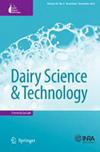牛奶蛋白衍生阿片肽控制阿尔茨海默病的抗胆碱酯酶抑制、药物相似性评估和分子对接评估
Q2 Agricultural and Biological Sciences
引用次数: 1
摘要
采用SwissADME和ADMETlab对23种乳蛋白类阿片肽的药物相似性和药代动力学特性进行了研究。所有的阿片肽都有很差的药物性质,这是基于违反利平斯基的五项规则。此外,对其药代动力学特性的预测表明,这些肽具有较差的肠道吸收和生物利用度。随后,从A1牛乳和咖啡因(阳性对照)中选择两种众所周知的阿片肽(βb-casomorphin-5、βb-casomorphin-7),对阿尔茨海默病发病机制中重要的两种胆碱酯酶受体进行硅分子对接和体外抑制研究。两种多肽的结合自由能和对丁酰胆碱酯酶(BChE)的抑制活性均高于咖啡因,但体外结合能值低于对接模型。此外,这两种酪啡肽对乙酰胆碱酯酶(AChE)的抑制性能低于咖啡因,尽管对接模型预测的结果相反。在1 mg/mL浓度下,βb-酪啡肽-5和βb-酪啡肽-7对两种胆碱酯酶均有良好的抑制效果(分别对AChE有34%和43%的抑制作用,对BChE有67%和81%的抑制作用)。这些乳源性阿片肽具有通过抑制胆碱酯酶治疗阿尔茨海默病的潜力。然而,可能需要适当的衍生化来改善其预测的不良肠道吸收和生物利用度。本文章由计算机程序翻译,如有差异,请以英文原文为准。
Anticholinesterase Inhibition, Drug-Likeness Assessment, and Molecular Docking Evaluation of Milk Protein-Derived Opioid Peptides for the Control of Alzheimer’s Disease
The drug-likeness and pharmacokinetic properties of 23 dairy-protein-derived opioid peptides were studied using SwissADME and ADMETlab in silico tools. All the opioid peptides had poor drug-like properties based on violations of Lipinski’s rule-of-five. Moreover, prediction of their pharmacokinetic properties showed that the peptides had poor intestinal absorption and bioavailability. Following this, two well-known opioid peptides (βb-casomorphin-5, βb-casomorphin-7) from A1 bovine milk and caffeine (positive control) were selected for in silico molecular docking and in vitro inhibition study with two cholinesterase enzyme receptors important for the pathogenesis of Alzheimer’s disease. Both peptides showed higher binding free energies and inhibitory activities to butyrylcholinesterase (BChE) than caffeine, but in vitro binding energy values were lower than those from the docking model. Moreover, the two casomorphins had lower inhibitory properties against acetylcholinesterase (AChE) than caffeine, although the docking model predicted the opposite. At 1 mg/mL concentrations, βb-casomorphin-5 and βb-casomorphin-7 showed promising results in inhibiting both cholinesterases (i.e., respectively 34% and 43% inhibition of AChE, and 67% and 81% inhibition of BChE). These dairy-derived opioid peptides have the potential to treat Alzheimer’s disease via cholinesterase inhibition. However, appropriate derivatization may be required to improve their poor predicted intestinal absorption and bioavailability.
求助全文
通过发布文献求助,成功后即可免费获取论文全文。
去求助
来源期刊

Dairy Science & Technology
农林科学-食品科技
CiteScore
2.30
自引率
0.00%
发文量
0
审稿时长
2 months
期刊介绍:
Information not localized
 求助内容:
求助内容: 应助结果提醒方式:
应助结果提醒方式:


